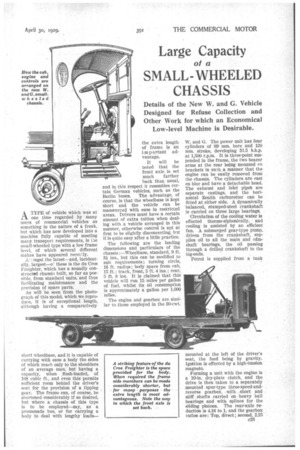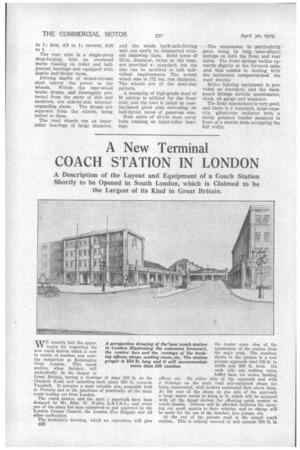Large Capacity
Page 55

Page 56

If you've noticed an error in this article please click here to report it so we can fix it.
ot a
SMALLWHEELED
CHASSIS•
Details of the New W. and G. Vehicle Designed for Refuse Collection and Other Work for which an Economical Low-level Machine is Desirable.
ALTYPE of vehicle which was at one time regarded by many users of commercial vehicles as something in the nature of a freak, but which has now developed into a machine fully capable of meeting many transport requirements, is tie small-wheeled type with a low frame level, of which several different makes have appeared recently.
A:-.3ngst the latest—and, incidentally, largest—o these is the du Cros Freighter, which has a soundly constructed chassis built, so far as possible, from standard units, and thus facllitating maintenance and the provision of spare parts.
As will be seen from the photograph of this model, which we reproduce, it is of exceptional length, although having a comparatively
short wheelbase, and it is capable of carrying with ease a body the sides of which reach only to the shoulders of an average man, but having a capacity, when flush-loaded, of 168 cubic ft., and even this permits sufficient room behind the driver's seat for the provision of a tipping gear. The frame can, of course, be shortened considerably if so desired, but where a chassis of this type is to be employed—say, as a promenade bus, or for carrying a body to deal with lengthy loads—
the extra length. of frame is an important advantage.
It will be noted that the front axle is set much farther back than usual, and in this respect it resembles certain German vehicles, such as the Berlin buses. The advantage, of course, is that the wheelbase is kept short and the vehicle can be manoeuvred with ease in restricted areas. Drivers must have a certain amount of extra tuition when dealing with a vehicle arranged in this manner, otherwise control is apt at first to be slightly disconcerting, but it is quite easy after a little practice.
The following are the leading dimensions and particulars of the chassis :—Wheelbase, standard, 9 ft. 31. ins., but this can be modified to snit requirements;. turning circle, 16 ft. radius; body space from cab, 15 ft.; track, front, 5 ft. 4 ins. ; rear, 5 ft. 8 ins. It is claimed that this vehicle will run 15 miles per gallon of fuel, whilst its oil consumption is approximately a gallon per 1,000 miles.
The engine and gearbox are similar to .those employed in the 30-cwt.
W. and G. The power unit has four cylinders of 89. mm. bore and 120 mm. stroke, developing 31.5 b.h.p. at 1,500 r.p.m. It is three-point suspended in the frame, the two bearer arms at the rear being mounted en brackets in such a manner that the engine can be easily removed from the chassis. The cylinders are cast en bloc and have a detachable head. The exhaust and• inlet pipet; are separate castings, and the horizontal Zenith carburetter can be fitted at either side. A dynamically balanced, stamped-steel crankshaft is carried on three large bearings.
Circulation of the cooling water is effected thermo-siphonically, and cooling is assisted by an efficient fan. A submerged gear-type pump, driven from the crankshaft, supplies oil to all the main and aimshaft bearings, the oil passing through a drilled crankshaft to the big-ends.
Petrol is supplied from a tank mounted at the left of the driver's seat, the feed being by gravity. Ignition is effected by a high-tension magneto.
Forming a unit with the engine is a 10-in, dry-plate clutch, and the drive is then taken to a separately mounted spur-type three-speed-andreverse gearbox, with short and stiff shafts carried on heavy ball bearings and with splines for the sliding pinions. The rear-axle reduction is 416 to 1, and the gearbox ratios are: Top, direct ; second, 2.25
to 1; first, 4.8 to 1; reverse, 6.00 to 1.
The rear axle is a single-piece drop-forging, with an overhead worm running on roller and balljournal bearings and equipped with double ball-thrust races.
Driving shafts of nickel-chrome steel convey the power to the wheels. Within the rear-wheel brake drums, and thoroughly protected from the entry of dirt and moisture, are side-by-side internalexpanding shoes. The drums are separate from the wheels, being bolted to them.
The road wheels run on taperroller bearings of large diameter, and the whole baCk-axle-driving unit can 'easily be dismantled without removing them. Solid tyres of 22-in, diameter, twins at the rear, are provided al standard, but the size can he modified to suit individual requirements. The actual wheel size is 171 ins, rim diameter. The wheels are of the steel-disc pattern.
A stamping of high-grade steel of H section is utilized for the front axle, and the load is taken on casehardened pivot pins swivelling on ball-thrust races of generous size.
Stub axles of 43-ton steel carry hubs running on taper-roller bearings. The suspension isparticularly good, being by long semi-elliptic springs on both the front and rear axles. The front springs incline upwards slightly at the forward ends, and this assists in dealing with the horizontal componenOpof the road shocks: Miller lighting equipment is provided as standard, and the dashboard fittings include speedometer, clock, oil gauge and ammeter.
The front appearance is very good, and there is a standard, large-capacity, gilled-tube radiator with a nicely polished header mounted in front of a Scuttle dash occupying the full width. •




























































































































